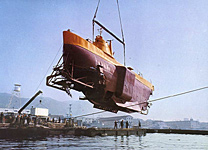SUBMERSIBLES
ref. # 014 'submarine' -Le Gymnote submarine, in 1889
 First electrical submarine, France 1889
First electrical submarine, France 1889©: Wikipedia
tags: #Gymnote #submarine
ref. # 014a 'submarine' -Cornelius van Drebbel
 The first successful submersible vessel was probably build around 1620 by the Dutch Cornelius Van Drebbel. A wooden watertight boat carried 12 rowers and a total of 20 men. This vessel made successful divings in the Thames River in a depth of 20 meters.
The first successful submersible vessel was probably build around 1620 by the Dutch Cornelius Van Drebbel. A wooden watertight boat carried 12 rowers and a total of 20 men. This vessel made successful divings in the Thames River in a depth of 20 meters.text from >www.mlahanas.de
The world's first practical submarine was built in 1620 by Dutch engineer Cornelis Jacobszoon Drebbel, under the patronage of James 1 of England. Drebbel built three submarines according to the sketchy information available from that time, each larger than the last and the third being capable of carrying 16 people, of which 12 were the oarsmen. No credible illustrations or accurate descriptions remain of Drebbel's submarine, though it seems the last of the three prototypes constructed was probably a decked over and heavily modified rowboat which was regularly seen in the Thames river undergoing trials.
http://www.gizmag.com
A painting of the period depicts the Drebbel submarine on the River Thames
link: Wikipedia
read this: www.gizmag.com about Drebble and his designs
©: G. W. Tweedale Drebbel's first submarine (Lithograp, e). 1626
tags: #Cornelius van Drebbel #submarine
014b 'submersible' -Scaphandre rigide
Le scaphandre d´Alphonse et de Théodore Carmagnolle, premiére tentative de scaphandre rigide anthropomorphe"An atmospheric diving suit is a small one-man articulated submersible of anthropomorphic form which resembles a suit of armour, with elaborate pressure joints to allow articulation while maintaining an internal pressure of one atmosphere.
These can be used for very deep dives for long periods without the need for decompression, and eliminate the majority of physiological dangers associated with deep diving. Divers do not even need to be skilled swimmers. Mobility and dexterity are usually restricted by mechanical constraints, and the ergonomics of movement are problematic." (Wikipedia)
Link: www.citedelamer.com
More pictures: dien-cai-dau.blogspot.nl
©: Robert Schilder 2015, photographed in Musee National de la Marine, Paris
tags: #Scaphandre rigide #
014c 'submarine' - Bathyscaphe
 "A free-diving self-propelled deep-sea submersible, consisting of a crew cabin similar to a bathysphere, but suspended below a float rather than from a surface cable. In 1960 ´Triëste´, carrying Piccard's son Jacques Piccard and Lt. Don Walsh, reached the deepest known point on the Earth's surface, the Challenger Deep, in the Mariana Trench 35,798 ft (10,911 m). The bathyscaphe was equipped with a powerful light, which illuminated a small flounder-like fish, putting to rest the question of whether or not there was life at such a depth in the complete absence of light. The crew of the Trieste noted that the floor consisted of diatomaceous ooze and reported observing "some type of flatfish, resembling a sole, about 1 foot long and 6 inches across" lying on the seabed."
"A free-diving self-propelled deep-sea submersible, consisting of a crew cabin similar to a bathysphere, but suspended below a float rather than from a surface cable. In 1960 ´Triëste´, carrying Piccard's son Jacques Piccard and Lt. Don Walsh, reached the deepest known point on the Earth's surface, the Challenger Deep, in the Mariana Trench 35,798 ft (10,911 m). The bathyscaphe was equipped with a powerful light, which illuminated a small flounder-like fish, putting to rest the question of whether or not there was life at such a depth in the complete absence of light. The crew of the Trieste noted that the floor consisted of diatomaceous ooze and reported observing "some type of flatfish, resembling a sole, about 1 foot long and 6 inches across" lying on the seabed."©: Wikipedia
tags: #bathyscaphe

